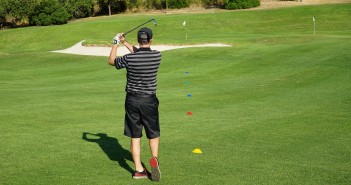Working the ball, shaping your shots, shot making… whatever you call it, this is the dream of every aspiring golfer, and in this series you’re going to learn how it’s done at the very highest levels.
There is much said about how to draw the ball in magazines and on the internet, but most of it is very crude, and aimed primarily at those golfers trying to eliminate a nasty slice. You’ve probably tried many of these drills, and they often work pretty well, but you soon realise that being able to hit “any old draw” isn’t enough to significantly help lower your scores and lead you towards true mastery of your game.
In this series, we’re going to take you much further. Here, you’ll learn how the world’s greatest players are able to hit a perfectly controlled little one-yard fade or draw, and how they finesse trajectory and spin, to create any shot they desire and attack pins in a way that most golfers can only dream of. You’ll make a lot more birdies and, as the great Bobby Jones used to say, you’ll be able to “turn three shots into two” much more often. This is ball striking nirvana!
What’s more, while we’re using these shorter, more controlled wedge play shots to teach you these techniques, they apply equally well to your full swing, and within a few weeks you’ll be shaping your shots at will from anywhere on the golf course.
You may have heard pundits say that certain great players are unable to work the ball, that they hit a natural draw or fade, and they can’t shape the ball the other way. That’s just not true. They may favour a certain shape of shot, and, because they know that they can rely on it when under pressure, they will choose this shape all day long when playing in a tournament, but that doesn’t mean that they can’t work the ball both ways when necessary.
Indeed, you must learn how to work the ball if you are going to achieve your golfing potential, it’s a crucial skill in gaining full control over your ball striking. Knowing how to shape your shots will help you to hit the ball straighter, because you’ll have more control over the strike, more feel, more finesse. And on days when your ball striking isn’t at its best, you’ll be able to feel why that is, to diagnose it, and to either correct it in-play or know how to work with it out on the course and fix it later.
As well as developing your ball striking skills, knowing how to work the ball will give you a huge strategic advantage out on the course:
- You may, as Ben Hogan did, wish to take one side of the course out of play. It may be, for example, that you have a full shot where there is serious trouble to the left of the fairway, or a wedge shot where missing to the left of the green would spell disaster. In both of these cases, for a right-handed player, the shot of choice should be a draw. This may seem counter-intuitive, given the way you’ve been taught to hit draws in the past, but once you know how to do it properly you’ll be confident of never missing left with a draw.
- You may need to work the ball around, over or under, an obstacle, such as a tree branch, to get the ball back in play and into a position that leaves you with a good chance of making par.
- You might need to hold the ball into a slope, to keep it on its line to the target or to stop it taking the slope and rolling into trouble.
- One of our favourite shots is holding the ball into a crosswind by curving the ball slightly against the wind’s direction, so that it flies straight. For example, imagine that you have a 75 yard shot to a pin tucked in the front-right of the green, and the wind is blowing off the right. You could just aim to the right of the pin and hope that the wind blows the ball back towards the hole, but, if the fickle wind doesn’t move the ball as you expect, you might miss the green to the right and leave yourself short-sided for the next shot. And even if you guess right, a ball that rides the wind this way will travel further and spin less, so getting it close to the pin may prove impossible, and you might be left with a long, tricky putt across the wind. If, however, you know how to shape your shots properly, you will be able to start the ball at the target and hold it on line with a controlled fade (for a right-handed player) – the ball will fly straight and land softly with “one hop and stop” spin near the pin, and even if you misjudge it slightly you’re still left in the middle of the green.
In all of these situations you’re probably saving at least one shot, and maybe several more!
And many elite players like to shape their shots “just because they can” – it gives them a feeling of sharper focus and greater control, that they “own” the shot.
Next up: in the first drill of this series, we’ll start you on the path to true mastery over your golf shots with the shot that golfers desire the most, the controlled draw, in Golf Wedge Play Drill 109a – Technique: How to Play a Controlled Draw.
This article is part of the Golf Loopy Score like a Champion series, the sensational new wedge play game improvement system that will help you to attack the pin from 120 yards and in. The improvements to your scores will be dramatic, and they will be permanent.




